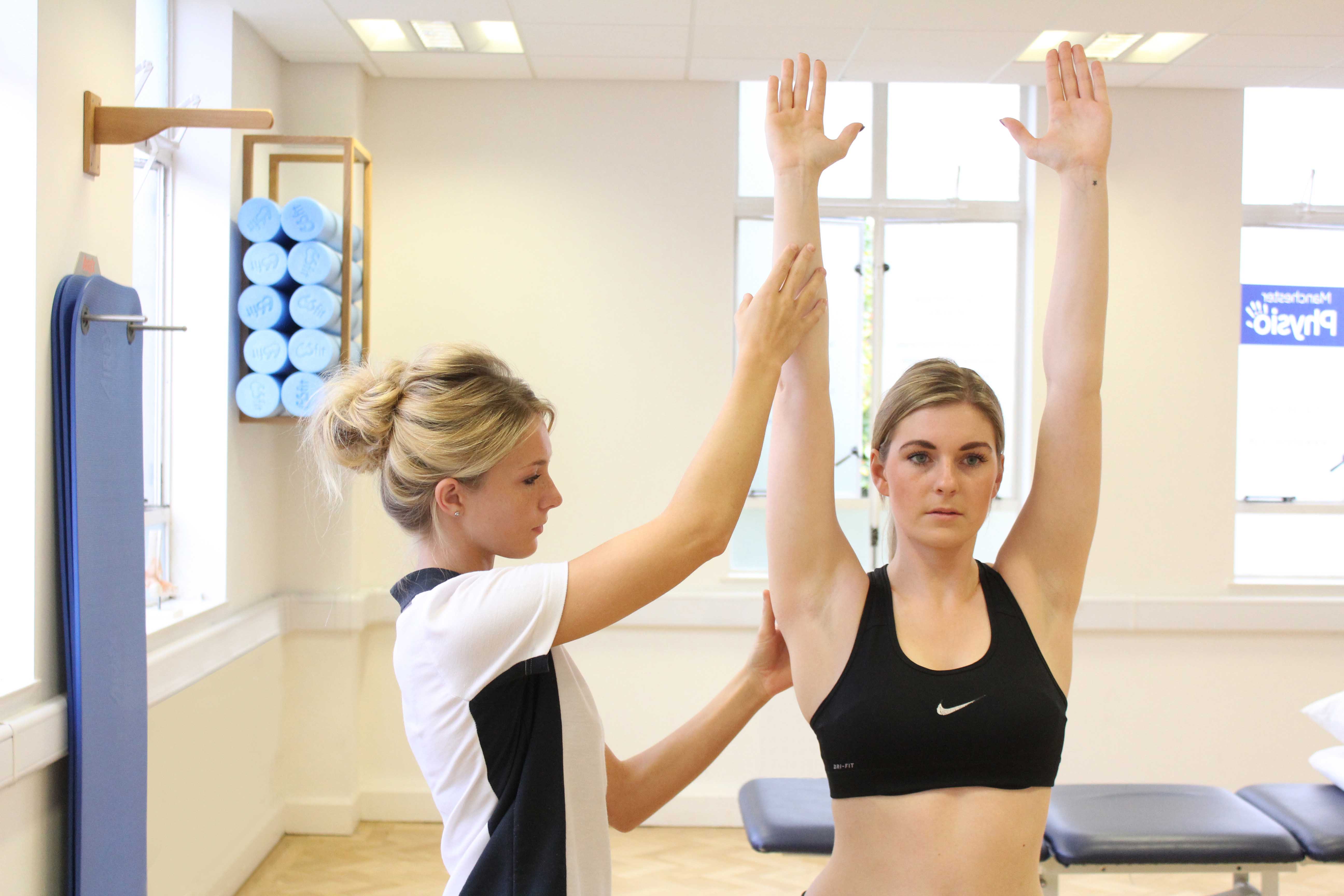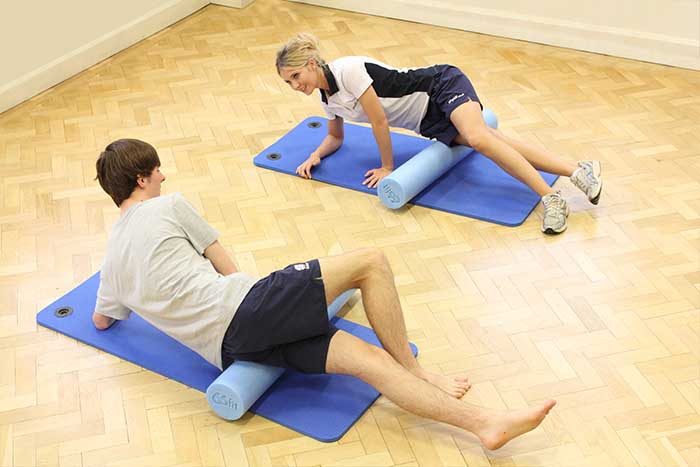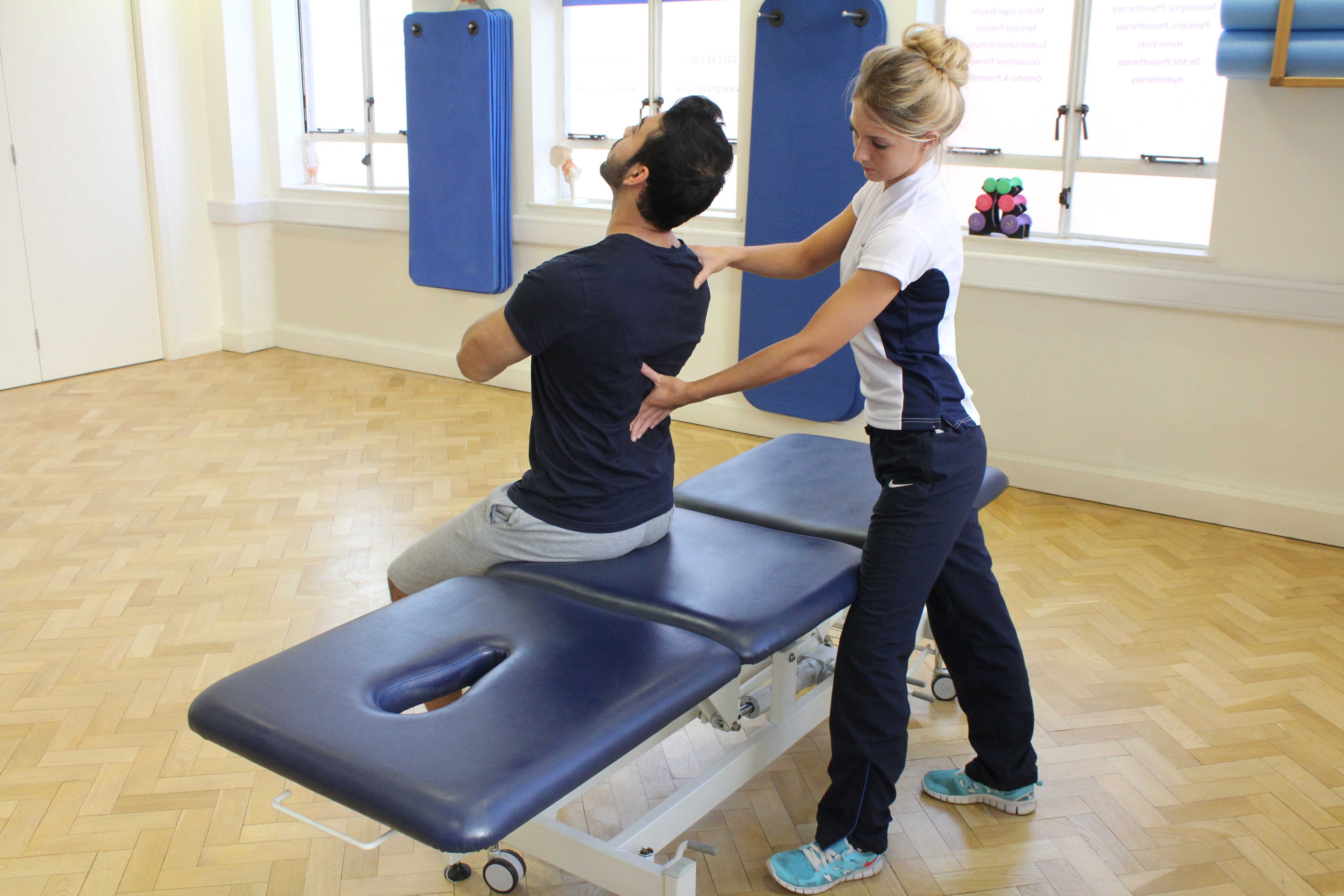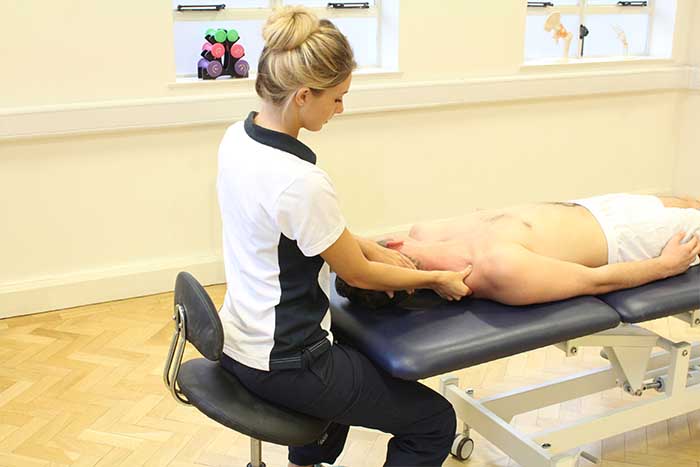Massage can often benefit posture. Poor posture occurs very often in a lot of different people. There are many different ways in which posture can be poor and many different reasons why it occurs. A persons posture can be kyphotic meaning the shoulders are brought forward giving the hunched effect, Lordotic meaning the stomach area is pushed forward making the buttock area stick out or have a flat back posture meaning there is no natural curve in the back. All different types of poor posture can be caused by a variety of reasons, the most common reasons being work and exercise. Poor posture can result in muscle tightness, joint stiffness and an increase in pain. Our massage therapists at Physio.co.uk improve posture through massage to help increase range of movement, reduce stiffness and increase mobility.
What are the most appropriate types of massage to improve posture?
Various types of massage are appropriate for improving posture. The most common types of massage used include:
 Above: Therapist coaching client on thier postural alignment
Above: Therapist coaching client on thier postural alignmentThe most common types of massage used to improve posture include deep tissue massage, sports massage and Swedish massage.
A deep tissue massage can be used to improve posture. A deep tissue massage focuses on the deeper layers of connective tissues and muscle fibres. Varied pressure is applied along the areas containing soft tissues, depending on the person's preference or the type of condition the therapist is treating. A deep tissue massage aims to reduce muscle tightness and restriction to help increase mobility and range of movement. Increasing mobility and range of movement allows posture to return to normal due to a decrease in restriction and a reduction in pain.
Posture is improved through sports massage. A sports massage is focused on areas containing soft tissues. Much like deep tissue massage, pressure used throughout a sports massage is varied depending on personal preference. A sports massage stimulates an improvement in blood flow to help increase muscle temperature. An increase in muscle temperature improves flexibility a a joint and elasticity of a muscle. An improvement in muscle and joint flexibility and elasticity increases range of movement and decreases pain and restriction. A decrease in pain and restriction enables posture to return to normal and increases relaxation.
A Swedish massage helps to improve posture. A Swedish massage can have a therapeutic effect on a person. A Swedish massage helps to relax a person both physically and mentally. A gentle or firm pressure can be used during a Swedish massage depending on person preference. A Swedish massage aims to relieve stress and tension within both muscles and joints. A build-up of stress and tension around the spinal area can cause stiffness and pain resulting in poor posture. Relieving stress and tension through Swedish massage help to reduce stiffness and decrease pain therefore improving posture as well as increasing relaxation.

What techniques are used to improve posture?
A wide range of techniques can be used to improve posture. The techniques most commonly used to improve posture include:
 Above: Therapist coaching client on thier postural alignment
Above: Therapist coaching client on thier postural alignmentThe most common techniques used to improve posture include deep strokes, mobilisations and myofascial release.
Deep strokes can help improve posture. Deep strokes are used on areas containing soft tissues and involve applying a deep pressure with flattened hands and fingers. The aim of deep strokes is to get deep within muscle fibres aiming to increase their temperature resulting in improved tissue elasticity and flexibility. Improved tissue elasticity and flexibility reduces muscle tightness due to an increase in range of movement. Muscle tightness is a common cause of poor posture. By reducing muscle tightness, posture is able to be improved and return to normal. Returning posture to normal helps to decrease pain and prevents muscle tightness from occurring again.
Mobilisations are often used to improve posture. Mobilisations are used along the spine and are were the joints are manipulated past their range of movement. A common cause of poor posture is stiffness around the spinal area which gives the hunched over effect on a person, bringing their shoulders forward and often tilting the head backwards. This kind of posture can cause an increase in pain and is most often work or exercise related. Mobilisations increase the range of movement at each joint in the spine by pushing and pulling the joints away from each other. Mobilisations can often be therapeutic as it relieves a lot of stress and tension around the spinal area. Stiffness at the joints is reduced when mobilisations are used, allowing a person to return their posture to normal without a feeling of pain.
Myofascial release is a technique regularly used to improve posture. Myofascial release is applied on areas containing soft tissues and fascia. Fascia surrounds structures in the body providing protection and support. Without fascia, movement would always be restricted and often painful. When an injury occurs, fascia tissue hardens as it becomes scarred. Hardened fascia tissue increases restriction and pain which often leads to poor posture. Poor posture can further increase fascia tissue restriction, worsening the effects of injury. Myofascial release aims to stretch and loosen fascia tissues. Fascia tissues increase in temperature during a massage, allowing the stretching and loosening to occur. Stretched and loosened fascia tissue reduces restriction and decreases pain. A reduction in restriction allows a person to return to their original posture.

When can a massage help to improve posture?
A massage can help to improve posture in a range of situations. The most common situations improved posture can help include:
The most common situations improved posture can help include acute pain, relaxation and tight muscles.
Improved posture can help reduce acute pain. Poor posture can lead to muscle tightness, joint stiffness and restricted movement which all increase pain. Stress can also increase due to the lack of movement allowed and increase in pain that occurs. During a massage posture is proved by the loosening of tight muscles and release of muscle tension. Mobility of joints also increases during a massage due to the specific techniques used throughout the massage. By reducing muscle tightness and increasing mobility to help improve posture stress decreases. A decrease in stress and improvement in posture reduce pain.
Relaxation is increased when posture is improved. Relaxation decreases both physically and mentally when movement is restricted and stress levels rise. Poor posture causes both restricted movement and stress to increase. Improving posture helps to physically relax a person as muscle tightness, pain and restriction are all reduced, allowing an increase in range of movement. Relaxation is mentally increased by improving posture due to the decrease in pain. A massage also stimulates the release of positive hormones within the body that all encourage relaxation. When posture is improved and pain is reduced positive hormones that circulate the body can give person a sense of relief and can give the happy mood feeling, both contributing to increased relaxation.
Muscle tightness is reduced when posture is improved. When posture is poor, muscles tend to tighten in order to increase stability of a person's core and keep them in an upright position. When muscles tighten movement is restricted and a build-up of tension can occur resulting in muscular knots. Tension and muscular knots can further increase muscle tightness and pain. Improving posture through massage helps to relieve the strain put on muscles to keep the trunk in an upright position, allowing them to relax. Relaxed muscles reduce muscle tension and relieve muscle tightness.
What are the physiological effects of massage to improve posture?
There are a range of physiological effects that occur during a massage to improve posture. The physiological effects that most commonly occur include:
The most common physiological effects that occur during a massage to help improve posture include increased vasodilation, increased temperature and increased tissue elasticity.
Increased vasodilation occurs during a massage to improve posture. Vasodilation is the relaxation of smooth muscles lining a vessel resulting in the widening of the vessels. The neurotransmitter histamine increases the permeability of blood vessels resulting in vasodilation. Increasing vasodilation encourages an improvement in blood flow due to a decrease in blood pressure. The widening of vessels and decrease in blood pressure allows an increase in blood to be circulated through the vessels. An increase in blood flow is used to rise muscle temperature, stimulating the relaxation of tighten and tense muscles. The relaxation of tight and tense muscles increases range of movement and improves posture due to a decrease in restriction.
Posture is improved when temperature increases. An increase in temperature occurs within both superficial and deep tissues around the body. The temperature of fascia can also increase. Fascia is a layer of fibrous connective tissues located beneath the skins surface. Temperature increases due to an increase in circulation. An increase in circulation occurs due to friction created between the skin and fingers. An increase in temperature decreases tissue inelasticity and also improves their flexibility. An increase in temperature can also improve mobility around a joint. Improving tissue elasticity and joint mobility both allow posture to improve and return to normal.
Increased tissue elasticity often occurs to help improve posture. The ability of a muscle to stretch to reach its full range of movement describes tissue elasticity. The most common types of tissues massage works on include both soft tissues and connective tissues. When tissues become restrictive, they can reduce movement and lead to poor posture. Tissue elasticity increases due to a rise in temperature. When tissue elasticity increases the flexibility of the tissues also increase, improving movement and decreases restriction. Increasing movement allows posture to be returned to normal without any pain.
Summary
Improved posture is the process of returning posture to normal after it has been affected due to a variety of reasons including exercise. A variety of massages can be used to improve posture including deep tissue massage, sports massage and Swedish massage. Techniques such as deep strokes, mobilisations and myofascial release are all used within a massage to help improve posture. There are many ways improved posture through massage can help a person including acute pain, relaxation and tight muscles. In order for posture to be improved a variety of physiological effects occur during a massage including increased vasodilation, increased temperature and increased tissue elasticity. Our massage therapists at Physio.co.uk improve posture through massage to help reduce pain, increase mobility and decreases joint stiffness.
How can I arrange a massage to improve posture?
The easiest way to arrange a massage to improve posture at Physio.co.uk, email us at office@manchesterphysio.co.uk or call us on 0161 883 0077.
You can also book an appointment online and save £10

 0330 088 7800
0330 088 7800


































